Test – Asus R9 280 Strix OC Edition: Review | Test | Specs | Price | CPU Performance| Setup| Config | Advantage (Pros) and Disadvantages (Cons) and other important features that will help you make better decision.
Please note– We love to be transparent as possible to our audience. The Review was done earlier than 2021 so their will be variation interims of the rate would earn when currency exchange is taken into consideration.
The Radeon R9 series was not without renaming older graphics cards from the 7xxx series, which is actually a big part of the lineup. Today I am going to get down to testing the Asus R9 280 Strix OC Edition, which is nothing more than a card with a Tahiti graphics chip identical to the Radeon HD7950.
This series of 7950 R9 280 should offer an excellent performance / price ratio like the 7950 in its day, which was for me the best card of the range. The Strix series offers a DirectCU II cooling system and a 0dB mode (the fans do not work) depending on the temperature of the GPU, we will see what this gives in practice.
Here is a summary table of the main characteristics of the Radeon Rx series:
| Menu | GPU | Transistors (in billions) | ROPs | GPU Frequency / Memory | Memory Capacity | Bus |
|---|---|---|---|---|---|---|
| R9 295X | 2x Hawaii | 2 x 6.2 | 2 x 64 | 1018 / 1250 | 2 x 4 GB | 512 bits |
| R9 290X | Hawaii | 6.2 | 64 | 1000 / 1250 | 4 GB | 512 bits |
| R9 290 | Hawaii | 6.2 | 64 | 947 / 1250 | 4 GB | 512 bits |
| R9 280X | Tahiti | 4.3 | 32 | 1000 / 1500 | 3 GB | 384 bits |
| R9 280 | Tahiti | 4.3 | 32 | 933 / 1500 | 3 GB | 384 bits |
| R9 270X | Pitcairn | 2.8 | 32 | 1050 / 1400 | 2 or 4GB | 256 bits |
| R9 270 | Pitcairn | 2.8 | 32 | 925 / 1400 | 2 GB | 256 bits |
| R7 265 | Pitcairn | 2.8 | 32 | 925 / 1625 | 1 or 2 GB | 128 bits |
| R7 260X | Bonaire | 2.08 | 16 | 1100 / 1625 | 2 GB | 128 bits |
| R7 260 | Bonaire | 2.08 | 16 | 1000 / 1500 | 1 GB | 128 bits |
| R7 250 | Holland | 1.04 | 16 | 1050 / 1150 | 1 GB | 128 bits |
| R7 240 | Holland | 1.04 | 16 | 780 / 1150 | 1 GB | 128 bits |
The Radeon R9 280 is therefore at the entry of the high end at AMD, performance should still be very good in current games despite the relative old age of the architecture. Let’s see what the Asus R9 280 Strix has in store for us 🙂
Characteristics
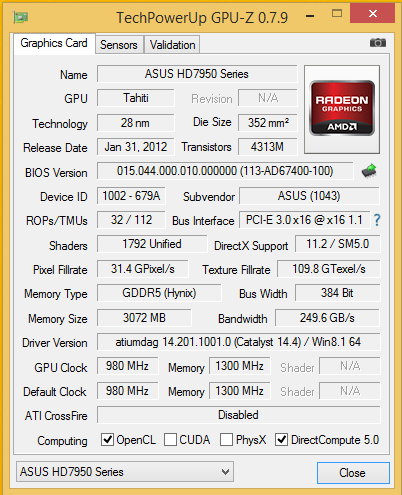
| Asus R9 280 Strix OC Edition | |
|---|---|
| GPU | Tahiti Pro2 |
| GPU frequency without boost | 827 Mhz |
| GPU frequency with boost | 980 Mhz |
| Memory Frequency | 1300 Mhz |
| Amount of memory | 3 Go de DDR5 |
| Memory bus | 384 bit |
| Connectivity | 1 x DL-DVI-I 1 x SL-DVI-D 1 x HDMI 1 x mini Display Port |
| Dimensions | 28,45 x 14,48 x 3,81 cm |
| Food | 1 x 6-pin 1 x 8-pin |
| Price | ~ 220€ |
| Guarantee | 2 years |
The Asus R9 280 Strix card exceeds the original specifications of the R9 280 (reminder: 933Mhz for the GPU and 1250 Mhz for the memory) to be overclocked to 980Mhz for the GPU and 1300Mhz for the memory, even if this overclock is not not huge it will still be good to take! For the rest we have seen and reviewed it for a few years with the radeon 7950 and the performance should be identical to the latter.
Offered at a price of around 220 € it is a little more expensive than the other R9 280s but the DirectCU II system and its 0dB function could perhaps make the difference, we will see that!
Box and bundle
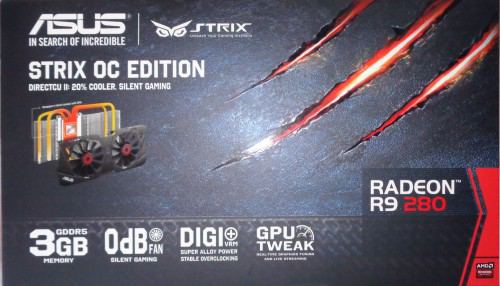
The box of the Asus Strix OC Edition is clearly aggressive, with claw marks showing that the beast wants it! Some characteristics are exposed such as 3GB of memory, 0dB mode as well as reinforced VRMs. Of course the model of the card is also present, it is better to know what you are buying anyway!
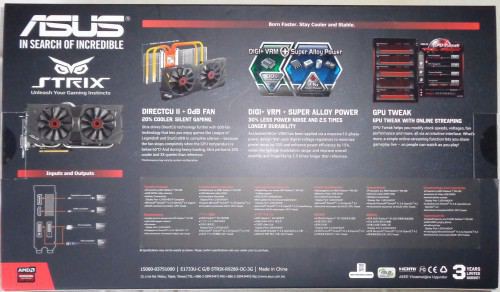
At the rear, the same characteristics as the front but with a small spill on each of them showing how these little extras will make all the difference.

The slice remains the most explanatory, no need to look either in front or behind in the end, have a look here and we know immediately what we have to do!

Once the cover is removed, we fall on the black box with the Asus logo in gold color, it’s very classy.

By opening the box we come across another box of the same black with the Asus logo in gold containing the bundle, everything is placed on the foam that separates it from the graphics card.
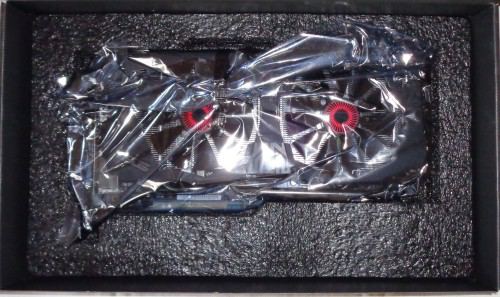
Here it is! Surrounded by thick foam and in its anti-static bag, the R9 280 Strix is waiting for someone to take care of it, it will not be long!
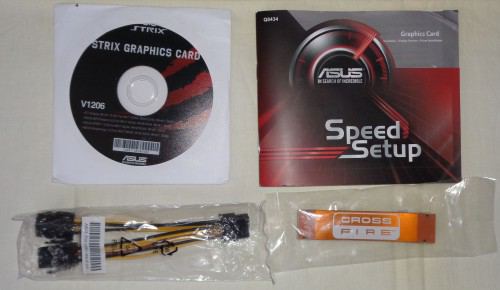
The bundle consists of:
- 1 adapter 2 x 6-pin PCIe -> 1 PCIe 8-pin
- 1 pont Crossfire
- 1 CD de drivers
- 1 manuel
As we can see the bundle consists of the bare minimum plus a 2 × 6-pin to 8-pin adapter.
Now on to the presentation of the card itself!
The map
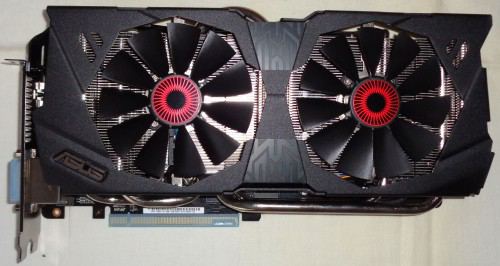
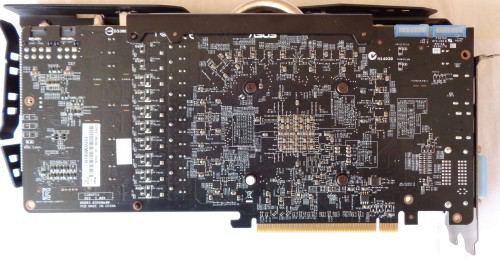
Here is the beast at last! Equipped with the DirectCU II cooling system and 2 9.2cm fans as well as a metal shroud, the card enjoys a really excellent finish and build quality! A plate connecting the square to the PCB gives a feeling of rigidity and the board should therefore not tilt in the case due to the weight.
The dimensions of the R9 280 Strix are generous with 28.4cm long and 14.5cm high without being excessive, it should be able to fit in a large majority of cases on the market.

The top view shows the 3 power connectors (6-pin and 8-pin), the 2 connectors for the Crossfire are equipped with a cover and we can especially see one of the huge heat pipes present and responsible for the routing of heat to the fins of the cooling system. The build quality is once again excellent.

Below are the 4 other heat pipes responsible for cooling as well as a cover for the PCIe connectors.
Time to strip the map I think you are all waiting for this!
We undress the map
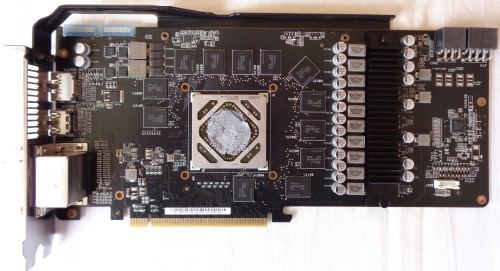
Once undress (easily with 4 screws) we discover the R9 280 Strix, unfortunately here there is no cooling plate covering a good part of the components (such as memory for example) but a single radiator on the VRMs. There is no need to worry anyway because in general the memory does not need any dedicated cooling, but it is still a bit of a shame.
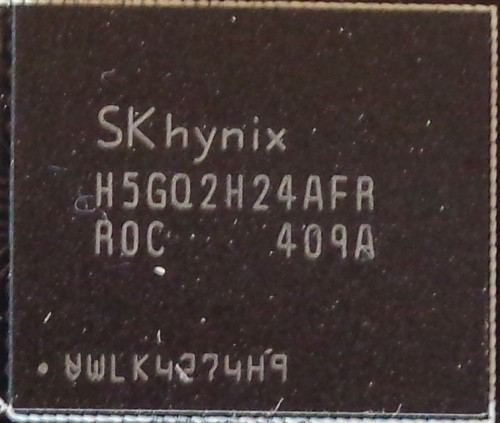
Speaking of memory, Asus has equipped its Hynix H5GQ2H24AFR R0C data chip card to operate at 1500Mhz, so it will probably be possible to overclock the memory to 1500Mhz without problems, to see in the tests!
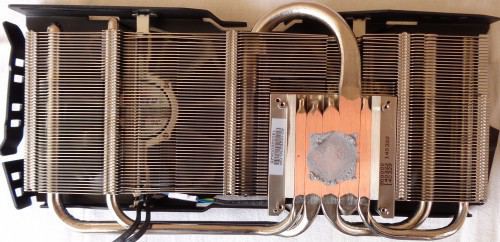
The radiator is composed of 5 large heat pipes and 53 fins, enough to have a very good cooling for the GPU.
The test platform
The configuration used during the tests is as follows:
- Processor : Intel Core i4670K @ 4 Ghz
- Motherboard : Gigabyte Z87-UD5H TH
- Mémoire: Kingston HyperX 4 x 2 Go 1600Mhz
- Disque dur: WD Raptor 150 Go
- Power supply : Seasonic X650
- Drivers: Catalyst 14.4 (AMD) & GeForce 337.88 (nVidia)
- Operating system : Windows 8.1 64bits
All games will be tested in 1920 × 1080 detail in full detail (except the TressFX on Tomb Raider), which is the current ‘standard’, the graphics cards used in testing are as follows:
- Asus R9 280 Strix OC Edition
- XFX R9 280 Double Dissipation
- HIS R9 290 iPower IceQ X² OC 4GB
- Sapphire 7950 Dualx @ 900Mhz
- Sapphire 7970 Ghz Edition
- MSI R9 280X Gaming
- Asus GTX770 DirectCU OC
Consumption / Temperature

Due to its more extensive overclocking than the other 7950 R9 280, the card from Asus consumes slightly more under load, this is quite normal and remains very moderate, going from 332Watts (XFX R9 280 DD) to 340Watts for the Asus!
The test was carried out on OCCT Power Supply so this consumption reflects the total consumption and the power of the machine, as you can see we are far from certain ideas received that a gaming PC needs a power supply of minimum 650Watts, the actual consumption of the components and taking into account an efficiency of 90% (80Plus Gold of the Seasonic X650) is in fact only 306 Watts!
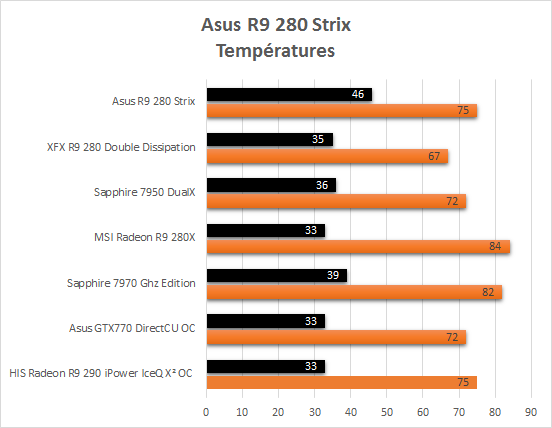
The Strix model from Asus and its 0dB functionality mean that the fans do not turn at rest and up to 65 °, the card therefore stabilizes at 46 ° at rest which is very good. Under load and with 75 ° the card is very well cooled even if the temperature is higher than the 7950 and R9 280, a choice on the part of Asus which will certainly have repercussions on a quieter operation, let’s see that!
Sound level
Warning: Part to be taken with a grain of salt, unfortunately not having access to the appropriate equipment and using an android application to take the readings The measurements below are only indicative! The readings were taken 20cm from the graphics card.
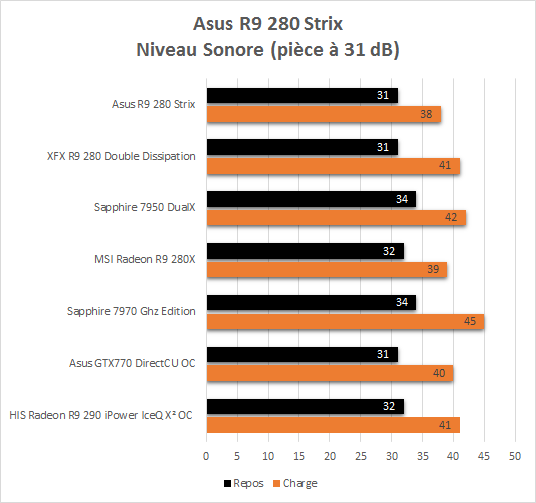
Bingo! By leaving a little more room for temperatures, the Asus Strix OC edition is the quieter card in the comparison! At rest, of course, the card does not add noise compared to ambient noise and when loaded with 38dB it will be very discreet.
3DMark Fire Strike
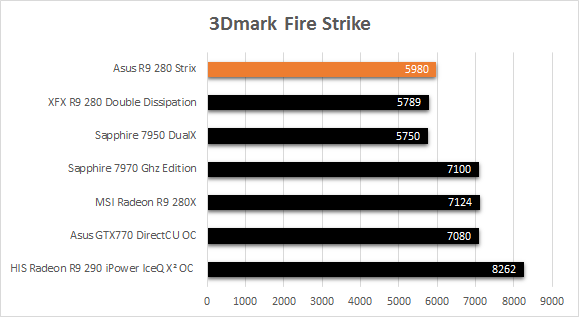
Under 3DMark the results are equivalent to other Tahiti Pro even if the Asus Strix OC Edition logically takes the upper hand thanks to its more extensive original overclocking.
Battlefield 4
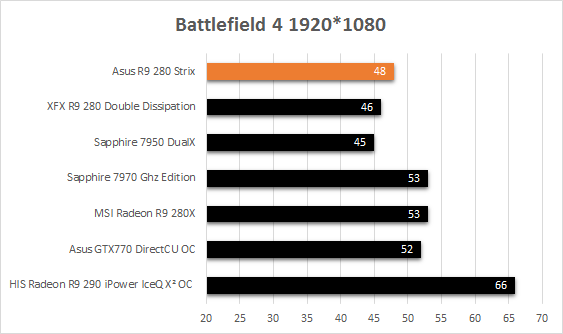
In Battlefield 4, the card from Asus has it in its belly and logically takes the first place of the Tahiti Pro and is placed at 5FPS of the 7970 Ghz Edition R9 280X.
Bioshock Infinite

With 63FPS the Strix OC Edition once again takes the advantage over its direct competitors with 7FPS less than the R9 280X.
Crysis 3
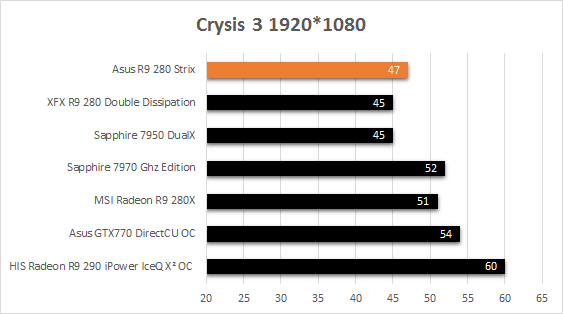
We take the same ones and start over, 47FPS for the Asus card against 45FPS for the 7950 and R9 280, 5FPS less than the R9 280X there is not really much difference here! The R9 290 is the only card here that can run the game smoothly at 60FPS, so the R9 280s don’t have to be ashamed.
Hitman Absolution
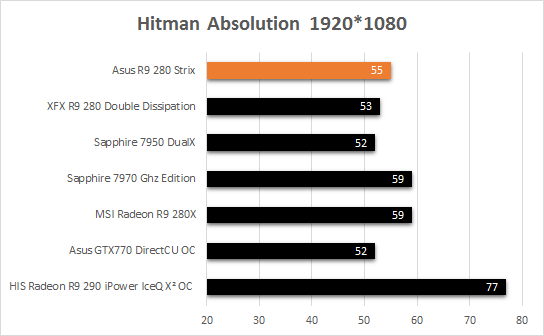
Still behind the R9 280X by a few FPS the Strix does not budge and remains the leader in its category.
Tomb Raider

We almost arrive at perfect fluidity for the Asus STrix here with 59 FPS, a small option less and the game should not be the slightest problem.
Summary of performance
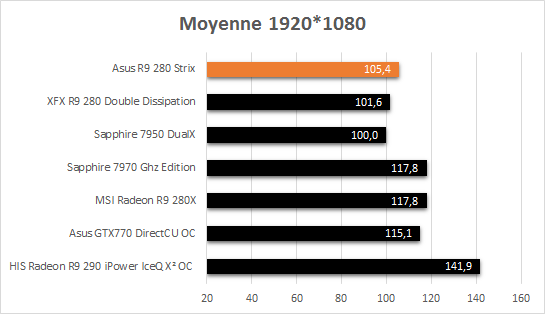
We start on a 100 basis for the Sapphire 7950 and it is of course obvious to find the Asus Strix OC Edition very close to this value with still 5.4% more performance, thanks to the factory overclocking! The gap between the R9 280 and the R9 280X is therefore reduced and is only about 12%, perhaps with a little overclocking the performance will be similar, we will see that below!
The R9 290 is of course out of comparison, the price is not the same.
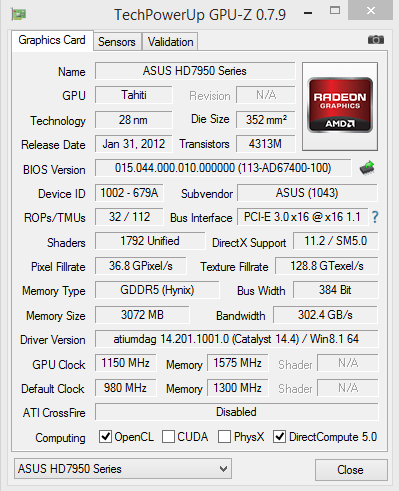
The Radeon 7950 in its day was already for the most part an excellent choice for overclockers because it had a rather enormous potential and would often titillate a 7970 (non Ghz) without exploding the scores in terms of temperatures and consumption. . I therefore have a lot of hopes in this Asus R9 280 Strix Oc Edition which, in addition to having excellent original performance, should be an excellent candidate for overclocking due to the proven and well-optimized architecture.
The maximum overclocking achieved with the original voltages is:
- GPU: 1150 Mhz (+170 Mhz)
- Memory : 1575 Mhz (+ 275 Mhz)
The results are quite simply very good, an overclocking of 17% for the processor and 21% for the memory compared to the original frequencies (which are already overclocked), and all without affecting the voltages! The memory is also fully adjustable in GPU Tweak! Asus or on Catalyst, too bad it could certainly have gone higher!
Regarding overclocking by touching the voltages, the card was unstable regardless of the voltages applied above 1150Mhz, too bad!
Powertune
To start, let’s take a look at the Powertune 2.0 that equips the R9 280. Powertune is responsible for keeping the temperature of the processor, the consumption of the card below certain values. During overclocking it is mandatory to be able to modify all the possible settings in order to get the best performance, for Powertune and the R9 280 series it is possible to increase the consumption limit of the card by 20% (50% for the R9 290 / 290X).
As I showed on the HIS R9 290 test (part on the Powertune here) Powertune can be a real brake on overclocking, what about the Asus R9 280 Strix OC Edition?
Powertune only activating on OCCT I have not noted the frequencies of the card under 3DMark.
There will be 3 different tests:
- OCCT with factory settings
- OCCT with factory settings + 20% at the consumption limit
- OCCT + 20% consumption limit, GPU 1150Mz, Memory 1575Mhz
OCCT Factory :

With Powertune left as is it comes to poke its nose in our business when the card is requested in OCCT dropping the original 980Mhz GPU to around 870Mhz sporadically. Let’s dig into the options a bit by increasing the consumption limit by 20%:
OCCT Factory + 20% :

Ah there we are! With a consumption limit increased by 20% OCCT no longer scares our Asus R9 280 Strix which is very happy to leave its GPU at maximum frequency, now that consumption is no longer a problem, instead of overclocking!
OCCT + 20%, GPU 1150Mz, Memory 1575Mhz :

Without increasing the GPU voltage the card should not consume a lot more and this is reflected in the graph which shows that Powertune does not care about overclocking to 1150Mhz and lets the card live its life quietly.
Consumption
The angry subject! It’s all well and good to “unleash” our precious graphics card by putting a little + 20% more consumption in the teeth, but this necessarily affects the total consumption of the machine. As on Powertune the readings will be made during the same 3 tests under OCCT.
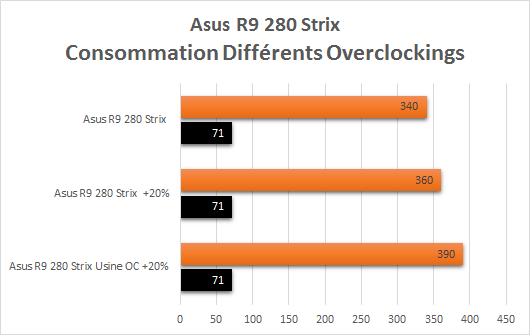
With 340 Watts of origin at the outlet (306Watts for the components taking into account the 80Plus Gold performance of the power supply) consumption is very contained, without forgetting that the processor is also a little overclocked. Once again, I would remind you that the test was carried out under OCCT Power Supply so this consumption reflects the total consumption and when the machine is taken.
Once the consumption limit has been increased by 20% and still with the original frequencies, the card consumes only 20Watts more and allows the GPU to remain at the same frequency without powertune intervening.
With maximum overclocking we take another 30 Watts to reach a maximum of 390Watts, which is still 50Watts more without even touching the voltage!
Nothing like a small summary table of all these figures in order to have a more global vision:
| Test | Consumption at plug | Difference from factory settings | Difference from previous settings | Estimated consumption of components |
|---|---|---|---|---|
| OCCT Factory | 340 W | – | – | 306 W |
| OCCT Factory + 20% | 360 W | +20 W | – | 324 W |
| OCCT +20% GPU 1150Mz Mémoire 1575Mhz | 390 W | +50 W | +30 W | 351 W |
Temperature
Overclocking also necessarily leads to an increase in the temperature of the components, more performance, more power, more heat to dissipate. The other important data to take into consideration when overclocking is to be successful is the temperature of the power supply stage (the VRMs), these small chips tend to heat up a lot and can block overclocking. well before the GPU temperature. Let’s see what the Asus R9 280 Strix OC Edition has in store for us at this level:
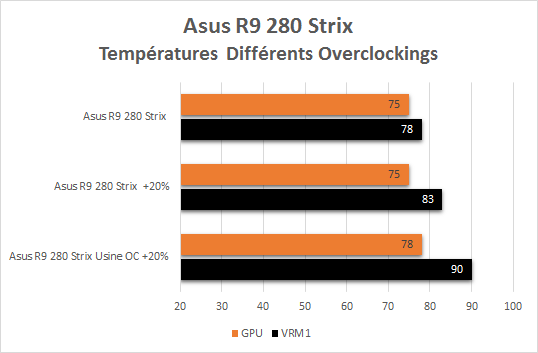
The temperature of the processor changes very little during overclocking, compensated by an increase in the speed of the fans. The temperature of VRMs rises faster to reach 90 ° in maximum overclocking, which is in no way bad because these little animals can reach 130 ° so there is room.
Sound level
Another unfortunate consequence for overclockers is the increase in noise levels, and in general on graphics cards it is better to wear a headset if you indulge in this kind of practice on an original cooling system.
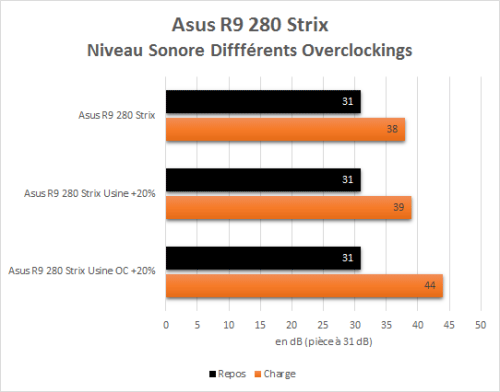
Increasing the consumption limit without overclocking has a very low impact going from 38dB to 39dB, which remains very quiet for a graphics card. Once the maximum overclocking has reached the card (and with 50Watts more to dissipate compared to the original settings) rises to 44 dB which finally shows that the card can be heard! Nothing too serious however because the readings being taken under OCCT the results in play will be much lower.
Results
Enough talking, time for results! Only results with maximum overclocking were noted.
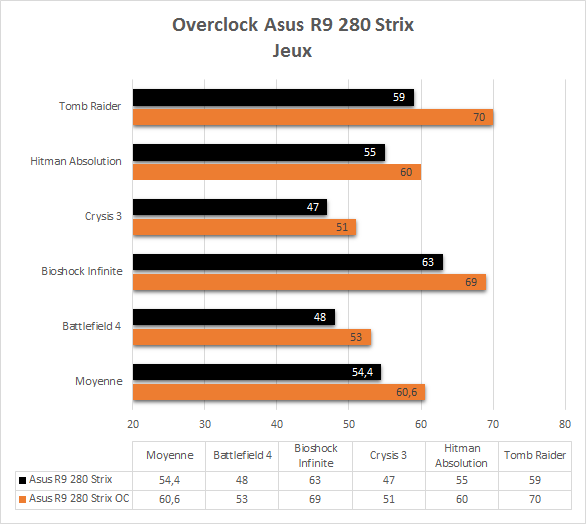
Well what do we see here? Wouldn’t that be substantial gains? With an overclocking of 17% for the GPU and 21% for the memory in addition to the original overclocking we arrive at a general increase in performance of 11.4%, which is quite significant! Let’s see what the performance is compared to other cards now, shouldn’t the 7970 Ghz Edition R9 280X be there?
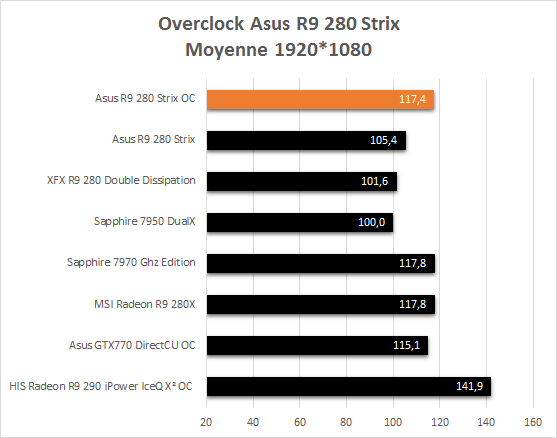
Effectively! The Asus R9 280 Strix Oc Edition once overclocked reaches the same level as an R9 280X, which is my faith a very good performance!
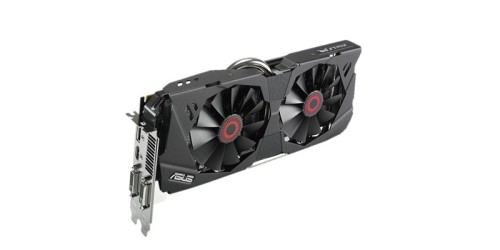
Here we are at the end of this article, what to say about the Asus R9 280 Strix OC Edition?
The build quality and finish are simply excellent, the cooling system is a delight for the ears with a 0dB mode up to 65 ° and very limited noise under load.
Overclocking level the card has managed to keep very good frequencies at the original voltages and thanks to this it achieves the performance of an R9 280X, which is not nothing! We can see that the Tahiti Pro chipset is very well mastered here after all its years and the R9 280 Strix from Asus is an excellent choice for games in Full HD (1920 × 1080).
The card can be found around € 220 which is a little higher than the competing R9 280s but thanks to its performance and its excellent cooling system it will do wonders in your gaming configuration.
Advantages
- Performances
- Overclocking
- Silent operation
- Build qualit
A big thank you to Yann from Text100 who allowed me to do this test.














